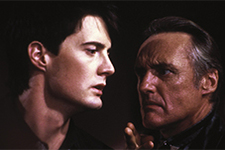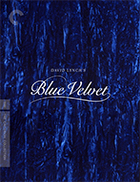Blue Velvet
|  It made Roger Ebert of The Chicago Sun-Times angry, and he denounced it as “sadistic” and “marred by sophomoric satire and cheap shots.” The New Yorker’s Pauline Kael, who was amazed by it, called it “the work of a genius naïf.” British author J.G. Ballard declared it the best film of the 1980s, while American critic John Simon wondered why so many laurels were being bestowed on what he considered “a piece of mindless junk.” When the National Society of Film Critics compiled an anthology in 1992 “on the most hotly debated movie controversies,” no one was surprised that it was the first entry. Most audiences didn’t like it at first and critics were befuddled by it, but the one thing that was never in doubt was that David Lynch’s Blue Velvet was an original—shocking, perverse, funny, unsettling, scathing, biting, and twisted, but undeniably original. Even those who hated it had to concede that it was unlike anything else out there. Set in the fictional northwestern town of Lumberton, which seems perpetually stuck in time (the clothing and architecture is all Eisenhower era, and even the cars don’t get newer than the early 1970s), Lynch’s odyssey into the moral and psychological decay hiding beneath the seemingly placid surface of small-town Americana jangled nerves and challenged even the most jaded of moviegoers when it debuted 25 years ago. Lynch had already made his name with Eraserhead (1978), his years-in-the-making surrealist oddity that became a midnight smash sensation and led to Paramount hiring him to direct The Elephant Man (1980), which won him mainstream acclaim and Oscar nominations. He had most recently completed Dune (1984), an ill-fated, big-budget adaptation of Frank Herbert’s science fiction opus produced by Italian mega-producer Dino De Laurentiis, which had already devoured the combined efforts of Alejandro Jodorowsky, H.R. Giger, and Pink Floyd a decade earlier. The film’s box office failure and critical pounding might have sunk the career of a lesser artist, but Lynch persevered, turning back to his independent roots with Blue Velvet, a film he had been developing on paper for the better part of a decade (and which De Laurentiis had to fund due to the deal he made with Lynch to direct Dune). Part of the film’s effectiveness is the way it takes familiar classical movie conventions, whether it be Hitchcockian voyeurism or the Capraesque charms of main street, and either turns them inside out or turns them against the audience. Every moviegoer is an inherent voyeur, a fact that Lynch not only recognizes, but exploits, and your response to the film (love it or hate it) will derive primarily from whether you feel used and abused by Lynch or exhilarated by his daring. Watching Blue Velvet is like being at the center of an elaborate practical joke: At the end you’re either mad for having been made a victim or you’re laughing with astonishment at how effectively the prankster got the best of you. The protagonist, Jeffrey Beaumont, is played by Kyle MacLachlan, who looks not a bit unlike Lynch with tamed hair and had previously worked with the director on Dune (in fact, many members of the cast had also appeared in Dune, including Dean Stockwell and Brad Dourif). Jeffrey is a student who has taken time off from college and returned to Lumberton after his father suffered a heart attack. While walking through a field between his house and the hospital, he finds a severed ear lying in the grass, a discovery that will propel him into his hometown’s barely hidden world of crime, sadomasochistic perversion, and violence. For Lynch, the ear is like a portal, and he moves his camera all the way into its darkness until we come out the other side, a kind of twisted variation on Dorothy not being in Kansas anymore. Jeffrey is, of course, still in Lumberton, but as he begins his own investigation into the mystery of the ear, he finds himself being drawn deeper and deeper into a netherworld that begins literally right around the corner. With the help of Sandy Williams (Laura Dern), the golden-haired, high school-age daughter of a local police detective (George Dickerson), Jeffrey sneaks into the apartment of Dorothy Vallens (Isabella Rossellini), a sultry night club singer who the police suspect is somehow involved with the case. Once inside, Jeffrey learns that Dorothy, far from being the dark-eyed femme fatale she at first seems, is actually the frail, rather pitiable victim of Frank Booth (Dennis Hopper), a sadistic, gas-huffing bully who may have kidnapped her husband and young son and is using her as a sexual slave (his fetishes stretch across the board, from wailing about “Mommy” and “Daddy” to stuffing the edges of Dorothy’s blue velvet robe into both his mouth and hers). Jeffrey is drawn to Dorothy and her to him, setting up a masochistic love triangle in which the eager young man is caught between two worlds represented by Sandy and Dorothy, two very different women. But are they so different? One of the tricks to Blue Velvet’s perversity is the way in which it subverts all forms of comfortable normality; its exists entirely in its own surreal fantasy world and only intermittently tricks us into thinking we’re watching something “real” (which is why complaints about elements of the film not making logical sense make no sense themselves). Even though Jeffrey and Sandy seem like well-scrubbed, clean-cut, good ol’ fashioned American kids, their curiosity betrays something much darker and more unnerving at their core. The idea of kids investigating mysteries that adults are incapable of solving is a staple of young adult fiction, from The Hardy Boys, to Nancy Drew, to Tintin, and Lynch uses our comfort with the conceit to push at boundaries, turning Jeffrey into a voyeur who hides in Dorothy’s closet and, once caught, can only say that he wanted to “see her.” He genuinely desires to solve the mystery, but more importantly, he wants to “see” all that has previously been hidden to him, which ultimately involves more than he bargained for. Sandy is really no different, even though Lynch presents her as a pragmatic counterbalance to Jeffrey’s overeager voyeuristic desires. Nevertheless, she ultimately goes along with all of his plans and is always willing to hear the gory details. And, let us not forget how Lynch first presents her: emerging from the pitch black outside her father’s home like a spirit or an illusion. Blue Velvet is ultimately all about illusions and delusions. The film’s most famous sequence is its first, which begins with stark, beautiful images of flowers against a white picket fence, a red fire engine driving along a leafy street, and children safely crossing the road to school. Because these images are presented with such intensity of color and the slightly distancing element of slow motion, they are immediately suspect, especially with Bobby Vinton’s 1964 hit recording of the gloomy titular pop song playing over them. Thus, it is less a shock than a natural development that these seemingly idyllic images give way first to Jeffrey’s father’s heart attack (in the yard while watering), and then to an extended tracking shot into the yard that burrows beneath the well-trimmed grass and finds a symbolic underworld of gnashing beetles and insects. This is the film’s most obvious symbolic moment, but it is also full of little nods to our culture’s unsavory desires, especially the recurring images of televisions tuned to old film noir. In this sense, Blue Velvet is not so much about the hidden violence and masochism beneath the surface of Norman Rockwell idealism, but rather how that violence is constantly bubbling to the surface and we are only deluding ourselves about its secrecy. In Lynch’s worldview, it is everywhere and in everyone; hence, any viewer discomfort with the film is not about being offended by something external, but rather about being unnerved by the recognition of our own heart of darkness. As Jeffrey keeps intoning, “It’s a strange world.”
Copyright © 2019 James Kendrick Thoughts? E-mail James Kendrick All images copyright © The Criterion Collection | |||||||||||||||||||||||||||||||
Overall Rating: 


 (4)
(4)


